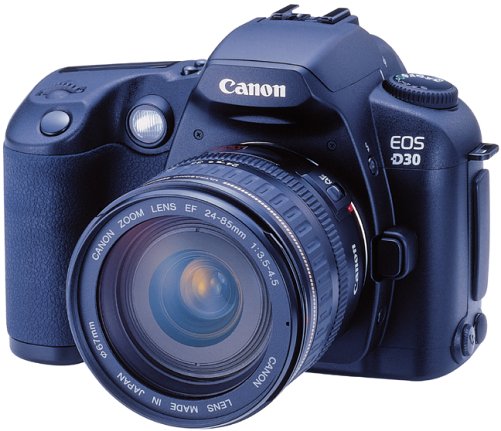Canon EOS D30 SLR Digital Camera (3.3MP )

The Canon EOS D30 is a high-end digital camera that will appeal to professional, semi-professional and serious amateur photographers who need the immediacy of digital photography together with the ability to produce high quality prints up to A3 size. As its name implies, the D30 is based on Canon's conventional (film) EOS 30 camera body and it has most of the functions you would expect from a top quality camera. There are also one or two useful extras on the 30s, such as the integrated dioptre dial to adjust the viewfinder for people whose eyes are less than perfect. However, there is a significant price difference between the EOS 30 and the D30, so is it worth paying the extra to "go digital"? Check out the following: The D30 has 5 photo-quality levels and, if required, this can be reset every time you take a photograph. The higher the quality you chose, the fewer images you can store on the flash memory card. If you chose the second-highest quality setting, you can only store 10, JPEG-formatted, images on the 16 MB flashcard provided with the camera. However, these compressed images will expand to c.9 MB in Photoshop and you can produce prints up to A3 that can be difficult to distinguish from conventional photographs. So, if quality is important, you might like to consider buying a larger flashcard. These may seem expensive to traditional photographers, but think of the film you will save (and slide films can cost up to £10 a time with processing). Remember also that, unlike film, you have no waste with digital photography because you can immediately view a photograph and discard anything that is not up to standard. This is particularly useful for difficult subjects and isn't it just great to be able to discover any problems and correct them on site instead of having to wait for the film to come back from processing? Another advantage of the D30 is that fact that you can adjust the equivalent film speed for each picture. Most of the time you will be shooting with 100ASA but it's good to be able to crank right up to 1600ASA for that special shot with very long lens or when lighting conditions are difficult. You can also adjust contrast, sharpness, colour saturation, and light balance, frame-by-frame. A major plus for nature photographers and the paparazzi will also be that all your Canon EOS telephoto lenses give an extra 1.6x the magnification with the D30. So if you own one of Canon's excellent 100-400 mm image stabilised lenses and a 2x teleconvertor, the D30 will give you a maximum focal length equivalent to 1280 mm (easily enough to twitch a photo of a icterine warbler from 25 yards or compromise a celebrity from a quarter-mile). Finally, there are significant output advantages. You won't need a scanner or imaging software because you can plug the D30 directly into a PC using the included USB cable. Then you download your photos into the software provided for adjustment and printing (The D30 package includes a photo browser, Photoshop LE, and a "stiching" program for producing panoramas). Alternatively, you might decide to sell your old slide projector and screen because in future you will be able to view your images on the telly by connecting the D30 directly to the video input socket of the TV. So, although the D30 might initially seem significantly more expensive, it does have many advantages over its analogue equivalent. And there are many potential savings in consumables (film, batteries), and hardware (film scanners), which bring the costs a lot closer over time. It's a tough call and, if it's one or the other, a lot will depend on how important the digital advantages are to you and how often you use a camera. Of course, if you can afford both, a D30 body would be great to have in your camera bag alongside an EOS 3 or 1V. --Paul Keene FRPS


No comments:
Post a Comment